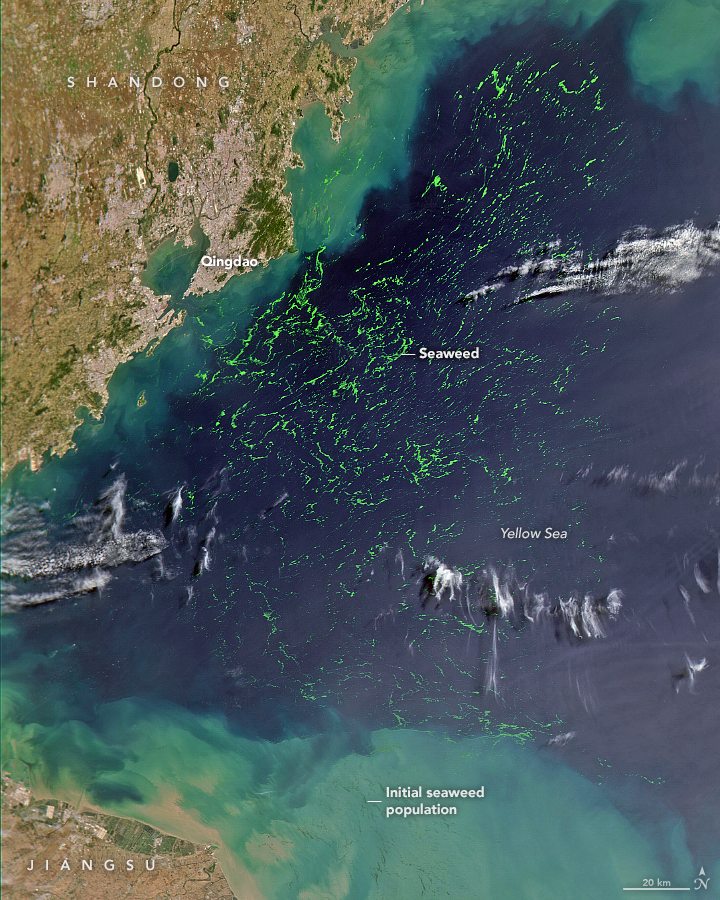

“Not bad for a shoebox.”
This quip, uttered by an engineer at NASA’s Wallops Island Near Earth Network (NEN) receiving station on March 22, 2019, is something NASA oceanographer Gene Carl Feldman will never forget.
The comment came in response to the successful downlink and processing of the first image from the HawkEye imager aboard the University of North Carolina-Wilmington’s SeaHawk CubeSat, currently in low-Earth orbit approximately 575 kilometers above the surface.

The goal of the SeaHawk mission was to prove a concept: that it is possible to collect scientifically credible ocean color data comparable to that of previous ocean color satellite missions from a 3U (or unit) CubeSat, a small, cube-shaped satellite (also known as a nanosatellite) measuring just 10-centimeters x 10-centimeters x 30-centimeters. The first successful download of an image from HawkEye proved it was.
“The mission could have ended at that moment, and we could have declared 100 percent success,” said Feldman, who specializes in ocean color remote sensing. “This was the first X-band downlink from a CubeSat that NASA had ever done. The data came down, it was processed flawlessly through the system — it was amazing! Everything worked. Here you have this 11-meter dish collecting data from something you can hold in one hand.”
The mission could have ended at that time, but, of course, it didn’t. Although pursued as a proof-of-concept, Feldman admits he had bigger plans for SeaHawk from the start.

“I didn’t think it would be worth NASA’s investment to do a one-off, get one image, prove the concept, and go home,” he said. “My goal from the beginning was to integrate this mission into the infrastructure that we have built over the past 25 years to support ocean color satellites, and to demonstrate that a CubeSat can be treated like a normal, credible scientific mission.”
Click here to read more about the origins, development, and performance of SeaHawk and HawkEye.

NASA image by Jeff Schmaltz, LANCE/EOSDIS Rapid Response.
Almost every volcano is interesting from a scientific perspective, but there are just too many eruptions for us to cover every single one. Instead we tend to focus on eruptions that have the potential to affect people. Or, occasionally our satellites return images that simply look so unique that we find the time to cover them. The plume recently ejected from Alaska’s Bogoslof Volcano was noteworthy for both reasons.
Bogoslof, which has been erupting since mid-December 2016, gave rise to a compelling two-tone plume. Are materials being ejected from a vent that is still under water? (Most of the volcano is below the surface of the sea.) The volcano’s interaction with seawater explains the white steam. But if the vent is not yet above water, then how did such a large, dark plume of ash reach so high in the atmosphere? Scientists at the Alaska Volcano Observatory continue to monitor the remote volcano and perhaps answers will be forthcoming as the eruption evolves.
Also intriguing are the swirls of blue visible in the image above. The Visible Infrared Imaging Radiometer Suite (VIIRS) on the Suomi NPP satellite captured the image on January 7, 2017. My first thought was that the color was caused by a bloom of phytoplankton. The milky blue color looked about right. And iron from eruptions have previously been shown to provide the nutrients needed for blooms to flourish. But when I asked the experts, the general consensus was that while you can’t rule out a bloom, there was another more likely explanation for the swirls.
According to ocean scientist Norman Kuring of NASA’s Goddard Space Flight Center:
“Phytoplankton don’t normally bloom in the Bering Sea during winter because there’s not a lot of sunlight and because winter storms deepen the mixed layer which also keeps the plankton more in the dark. Wave action can resuspend bottom sediments, and that may be happening farther east along the Aleutian chain in the January 7 image where the water is relatively shallow. Bogoslof Island is beyond the shelf break, however, so bottom resuspension is less likely. Ash in the water seems most probable…. I wouldn’t expect the Bering Sea to be nutrient limited in the winter, so I don’t expect an ash-based phytoplankton boost.”
In short, the swirls are probably ash in the water. The phenomenon is not unprecedented. We have previously published images of the occurrence here and here. But as Kuring reminds us, “the only way to know for sure would be to sample the water directly.”